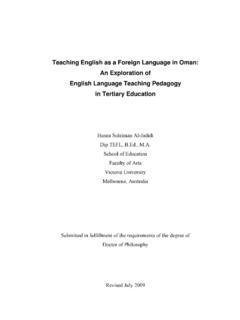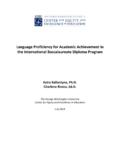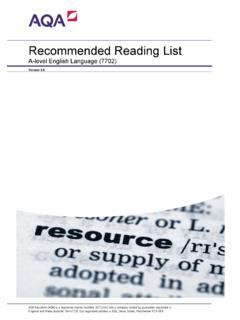Transcription of Effectiveness of Teaching English Subject using …
1 IOSR Journal of Research & Method in Education (IOSR-JRME) e-ISSN: 2320 7388,p-ISSN: 2320 737X Volume 4, Issue 6 Ver. I (Nov - Dec. 2014), PP 54-63 54 | Page Effectiveness of Teaching English Subject using drama on the Development of Students' Creative Thinking Dr. BashayerRaghianAlbalawi Assistant Professor of TEFL, Curriculum and Instruction Department Faculty of Arts & Education Tabuk University Abstract: The present study investigates the influenceof Teaching English Subject using drama on the development of intermediate students' creative thinking. The sample population of the study comprises two randomly selected first year intermediate classes of the 33 intermediate female school in Tabuk. One class of 24 students has been assigned to be control group. The other class of 23 students has been assigned to be experimental.
2 Upon review of related literature and previous studies, 4 dramatic Teaching scenes were prepared in the light of drama for each lesson in unit 10 (the body) of first year intermediate English Subject . Tool (Torrance creative thinking test) was adopted upon review of literature and related studies. Validity and reliability of the tools have been measured. Applying the pre-test of creative thinking for both control and experimental groups. The control group has been taught using the traditional way of Teaching whereas the experimental group has been taught using post--test of creative thinking applied by the end of Teaching the assigned was statistically have been on results recommendations and suggestions have been occurred. I. Introduction Tell me and I forget. Teach me and I remember. Involve me and I learn (Benjamin Franklin).
3 Students' involvement in the learning process has become the main aim of modern approaches that focus on student-centered class rather than teacher-centered class. Clever involvement that demands a student to use creative thinking skills is the kind of involvement that helps student to learn effectively. Many methods has been used to assess students' effective involvement. drama is one of the most important methods that provide much more involvement for both teachers and students in the learning process. In foreign language classroom, drama is an effective method as Mattevi (2005) states "the use of drama in the language classroom allows the teacher to present the target language in an active, communicative and contextualized way. Dramatization helps the teacher address the four skills of language learning (speaking, listening, writing and reading), and it also favors and facilitates the study of some often neglected aspects of language such as pronunciation and body language.
4 " Blanch (1974) also points out "the two elements of drama are action and dialogue, and both have a place in the foreign-language learning experience. They may be introduced into the classroom by means of a " drama lab," a learning activity that permits students to act out foreign language materials such as tableaus, poetry, ballads, folklore, and plays. drama allows the student to express his individuality, and the material, if it is culture-related, brings to life the cultural context of the foreign language." Campbell (2008) study proved the Effectiveness of using drama on students' achievement whereas the effect of drama in foreign language Teaching and learning has been the aim of many researches such as Barreto (2014), Gomez (2010),Baraldi (2009), Uddin (2009),Ntelioglou (2006), Culham (2003) and Gaudart (1990). drama also approved its Effectiveness on developing creative thinking.
5 Zdemir and akmak (2008) states " drama enables students, in all levels of education, develop their intellectual skills such as creativity, problem solving, communication, socialization and empathy and it gives individuals the opportunity for self-actualization, group work and sharing their responsibilities."Many studies revealed the effect of drama on creativity such the study of Ortiz-Seda (1984),Dupre (2006)and Taskin (2013). using of drama in foreign language class has many advantages. Cunico (2005) states that " drama is an under-exploited resource in the foreign language classroom for promoting intercultural competence and developing an awareness of the interpersonal dimension embedded in the language we use. drama also offers ample opportunities to explore nuances of the foreign culture as well as conflict situations and emotions which are seldom encountered in textbook dialogues and material, thus opening up to the students a world which is often denied to them in the foreign language classroom".
6 Emphasizing this Gasparro and Falletta (1994) point out "The use of poetry as drama in the English as a Second Language (ESL) classroom enables students to explore the linguistic and conceptual aspects of the written text without concentrating on the mechanics of language. Students are able to develop a sense of Effectiveness of Teaching English Subject using drama on the Development of Intermediate .. 55 | Page awareness of self in the target culture through dramatic interpretations of the poems. Teachers using this technique need to consider poetry that matches their students' language skills, ages, and interests." Even (2008) adds that through drama , "Students enter imaginary worlds that they cooperatively construct, experience, furnish, arrange, and , drama situations can liberate and at the same time deeply stimulate and challenge learners' take on communicative situations, grammar, and literary texts" The effect of drama also extend to the affective skills of the students.
7 Zdemir and akmak (2008) points out "a number of studies of the effects of drama on individuals cognitive and affective characteristics have been carried out recently. These studies revealed that drama had positive impact on students development of communication skills, socialization levels, development of emotional intelligence, social skills, empathic skills and empathic tendencies regardless of the grade levels of the students". Kao, etal. (2011) also stressed, "In drama -oriented English as foreign language (EFL) classrooms, teachers often ask questions to shape the story, unveil the details, sequence the scenes, create a beneficial linguistic environment to elicit student output and promote meaning negotiation in the target language." Therefore, "for more than 30 years drama has been promoted as a valuable Teaching tool for language learning.
8 Recent research results have reinforced this position." ( Dunn& Stinson, 2011). Culham (2003) observed benefits from using simple drama activities with students and in teacher-in-service workshops as follows: 1. Students are able to express themselves in ways other than through words. 2. drama activities offer community-building opportunities in a classroom where there are students of varying levels of language proficiency 3. Teachers are also able to use non-verbal cues to demonstrate caring and concern for students in a way that more formal language instruction does not allow, bound as it is by the physical constraints and the pressure to understand. 4. Non-verbal drama activities provide an excellent means of releasing the stress of language learning. 5. Students, often hesitant to speak out, can become confident when the language expectation is removed entirely.
9 6. Total Physical Response is enhanced through drama activities. 7. In all drama work, power dynamics shift as the teacher becomes a participant alongside the students. 8. Non-verbal drama activities transfer directly to verbal ones, and subsequent verbal interchanges are triggered by these non-verbal activities. On the other hand, Burke and O Sullivan (2002: xx) identified seven reasons to incorporate drama in the second language classroom: 1. Teachers and students can concentrate on pronunciation. 2. Students are motivated. 3. Students are relaxed. 4. Students use language for real purposes. 5. Risk-taking equals heightened language retention 6. Community is created. 7. Students and teachers can approach sensitive topics Emphasizing the importance of drama in language Teaching , Kao and O Neill (1998: 4) state in their book, Words into Worlds: " drama does things with words.
10 It introduces language as an essential and authentic method of communication. drama sustains interactions between students with the target language, creating a world of social roles and relations in which the learner is an active participant. drama focuses on the negotiation of meaning (Snyman& De Kock, 1991). The language that arises is fluent, purposeful and generative because it is embedded in context. By helping to build the drama context, they develop their social and linguistic competence as well as listening and speaking skills." However, drama is used in the present research to represent the educational drama used for learning not drama as an atr( ) the use of drama as method, as a means of learning other subjects. According to Taylor (2008) "Narrowing the term in that way paves the way for a conceptual move which set up ` drama as learning' in opposition to ` drama as an art form' (when drama is taught as a separate Subject discipline) without further exploration.















